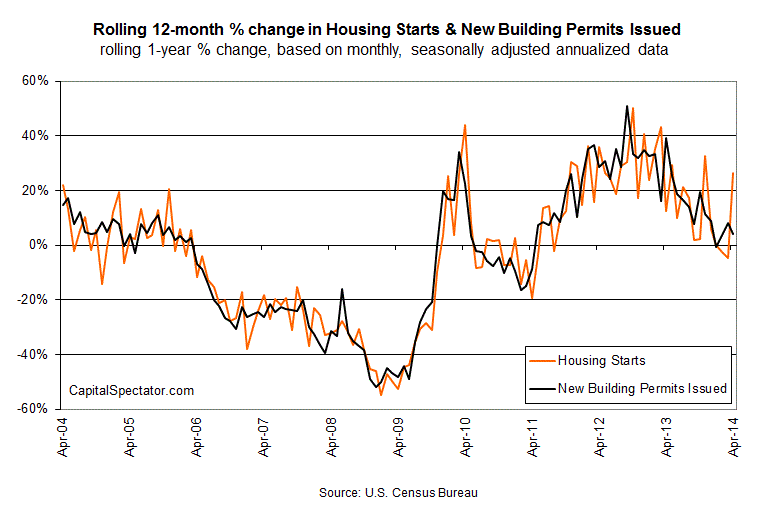Residential construction picked up last month, according to the US Census Bureau. Housing starts beat expectations and increased to an annualized rate of 1.072 million units on a seasonally adjusted basis—the most since last November. More permits were issued last month as well: 1.080 million (annualized) in May, the highest number since the recession ended in mid-2009. The monthly gain delivered a dramatic boost to the year-over-year in comparison for starts, which increased more than 26% last month vs. a year earlier. That’s the strongest annual rate since last November. Permits, however, slumped a bit in the annual comparison, decelerating to a slim 3.9% advance.
Despite the good news in today’s release, the weaker year-over-year trend in permits is worrisome. As you can see in the chart below, gravity still seems to have a grip on plans for new construction (black line). The sharp rise in building activity paints a considerably brighter picture, but the wide divergence at the moment between starts and permits on a rolling 12-month basis leaves plenty of room for caution. One of these data sets is misleading us.
Only time will sort out the mixed message. Meantime, it looks like we dodged a bullet. The disappointing news for home sales in recent months has cast a shadow over the outlook for housing. Today’s report suggests that the sector may be stabilizing. But even if April’s strong rebound in starts is a reliable benchmark, the macro benefits may be increasingly light going forward.
Consider that growth in the single-family corner of new construction was tepid last month, advancing a thin 0.8% vs. the previous month. That’s a sore spot if it continues. Quite a lot of the economic growth that comes from an expanding housing sector is bound up with single-family units. That’s because new construction and purchases of the traditional family home triggers significantly more economic activity vs. multi-family units.
“The headlines look great but all the action is in the hyper-volatile multi-family components,” notes Ian Shepherdson at Pantheon Macroeconomics. “The multi-family trend is rising, by contrast, reflecting strong rental demand, though the April number overstates the underlying pace and will partly correct in May.”

Pingback: Housing Starts Beat Expectations